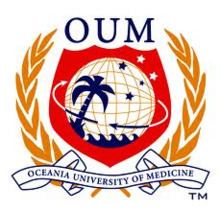Established 2002 (2002) Chancellor Dr. Chris May Headquarters Apia, Samoa | Chairman Taffy Gould Vice-Chancellor Dr. Viali Lameko Founded 2002 | |
 | ||
Type public-private, for-profit Similar National University of Samoa, Open University Malaysia, Fiji School of Medicine, International University of the He | ||
Oceania university of medicine top 5 facts
Oceania University of Medicine (OUM) is a public-private, for-profit medical school located in the South Pacific in Oceania. The medical school was founded in 2002 and is located on the island nation of Samoa. OUM was created by philanthropist Taffy Gould, a handful of Australian doctors, and several others to fill a void, a shortage of medical personnel in the South Pacific area. Due to Samoa's and the surrounding islands' remote location, an online curriculum with local physician mentors evolved. It became clear that aspiring phsycians in other areas around the world were experiencing similar barriers in pursuing a medical degree due to geographical isolation and/or personal commitments. Soon OUM began receiving applications from all over the world. The OUM curriculum is divided into two phases, preclinical and clinical. The preclinical phase is offered via distance learning while the clinical phases offers hands on learning in a clinical setting at regional teaching hospitals.
Contents
- Oceania university of medicine top 5 facts
- History
- Recognition Accreditation
- Faculty
- Student Demographics
- Curriculum
- References
History
Oceania University of Medicine (OUM) operates under a charter executed by the Government of Independent Samoa (formerly Western Samoa), as an autonomous statutory corporation operating in partnership with the Samoan government, represented by the Prime Minister. The school’s authority derives from the Oceania University of Medicine Act, ratified by the Parliament of Samoa in January 2002. e-Medical Education, LLC, an international software and health science education company, operates OUM as part of the agreement.
The mission of Oceania University of Medicine is to produce physicians with the requisite knowledge, skills, and attitudes to improve the health of underserved communities in Oceania and beyond, via traditional and innovative instructional modalities to help individuals overcome distance, personal and professional barriers to realize their calling to the medical profession. OUM students are required to complete at least one four week clinical rotation at OUM's home in the South Pacific. Clerkships are available in the nation of Independent Samoa and the US territory of American Samoa. Just west of the Dateline, in Independent Samoa, two-thirds of the country’s population lives on the largest island, Upolu, which is also where the capital, Apia, and national hospital are located. The National Hospital is in the village of Motootua, a suburb of Apia. Available student housing is located within walking distance of the health complex. Located east of Independent Samoa and the International Dateline is American Samoa. The capital Pago Pago, is home to LBJ Tropical Medical Center which also hosts OUM students from the United States, Australia, New Zealand, and other countries.
Recognition & Accreditation
OUM is listed in the World Directory of Medical Schools, a joint project of the World Federation for Medical Education (WFME) and the Foundation for Advancement of International Medical Education and Research (FAIMER) and in the International Medical Education Directory (IMED). It is recognized by the Education Commission for Foreign Medical Graduates (ECFMG). OUM was granted formal accreditation by the Philippine Accrediting Association of Schools, Colleges and Universities (PAASCU) in 2010, making OUM the only internationally accredited medical school in the South Pacific. In May 2015, PAASCU re-accredited OUM for a five-year period. PAASCU is one of 20 accrediting bodies recognized by the US Department of Education’s National Committee on Foreign Medical Education and Accreditation (NCFMEA). NCFMEA identifies and vets accrediting bodies outside of the United States that use standards comparable to those used to accredit medical schools in the United States.
Faculty
The OUM faculty reflects the diversity of the student body. Faculty from Australia, New Zealand, and the United States work collaboratively to deliver a common internationally-applicable medical curriculum based largely on American and Australian medical education standards. There is also considerable focus on the various licensing standards and requirements for the countries where graduates intend to practice. All faculty have earned MBBS, MD, PhD, and other terminal degrees in their fields. Faculty members teach classes and also serve as academic advisors.
Student Demographics
OUM’s flexible program appeals to a wide variety of students—from recent college graduates, to working professionals interested in changing careers, with the average age of 40.5 years and a range of 24–62 years of age. The distance-learning component is attractive to those already in the medical field. Much of OUM's student body is made up of nurse practitioners, nurses, chiropractors, physical therapists, physician assistants, pharmacists, paramedics, respiratory therapists, podiatrists, and other healthcare professionals. Approximately half OUM's students hold master's degrees and ten percent have earned a doctorate. The majority of OUM students live in Australia, New Zealand and the United States but the student body actually represents more than 40 countries of origin. OUM graduates currently are completing residencies or felllowships or working as practitioners in Australia, Canada, New Zealand, Samoa, and many metropolitan areas of the united States.
Curriculum
The OUM MD program consists of a preclinical component, available online and lasting a total of 96 weeks, followed by 72 weeks of clinical rotations learning hands-on patient care in a teaching hospital. The preclinical curriculum is delivered via e-lerning technology, allowing students to participate in group discussions and interact with faculty in a virtual classroom setting. While students may access the preclinical modules remotely, the 72 weeks of clinical clerkships take place at teaching hospitals in Australia, Canada, New Zealand, Samoa, the United States, and other countries with suppemental online lectures. OUM's programs operate on a rolling admissions schedule that allows new students to enroll in January or July.
External Links
http://www.oum.edu.ws/ Official Website
http://www.oum.edu.ws/graduateMD/images/stories/pdf/Catalogue%202014-15%20FINAL.pdf 2014-2015 OUM Catalogue
